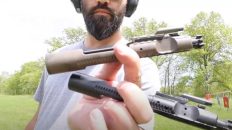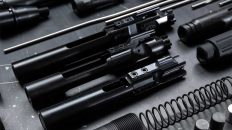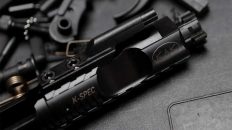Are you a gun enthusiast looking to dive deeper into the mechanics of your firearm? Understanding the ins and outs of the bolt carrier group (BCG) is essential for anyone interested in the functioning of semi-automatic or automatic firearms. The BCG plays a pivotal role in cycling the action of these firearms, ensuring that each round is ready to fire reliably.
In this article, we will dive into the details of the bolt carrier group, examining its construction, functionality, and the various types available. We’ll explore the critical features to consider whether you are thinking about purchasing a new firearm or upgrading an existing one. Additionally, we’ll discuss the different materials used in manufacturing BCGs, such as stainless steel, titanium, and nickel boron, and highlight the benefits of advanced coatings and finishes, like the benefits of a chrome BCG, that contribute to enhanced durability and smoother operation.
This guide is designed to equip both seasoned shooters and newcomers with the knowledge needed to make informed decisions about their bolt carrier groups, enhancing both the performance and enjoyment of their firearms.
Historical Insights: Tracing the Roots of the Bolt Carrier Group
The bolt carrier group (BCG) is not just a pivotal firearm component; it is a testament to the ingenuity and continuous innovation in firearm technology. Its evolution can be significantly credited to early 20th-century advancements in automatic firearms. Renowned firearms historian Bruce N. Canfield provides an extensive overview of these developments in his studies on automatic rifles. Specifically, Canfield discusses how the Browning Automatic Rifle (BAR) revolutionized military engagements by introducing reliable, rapid-fire capabilities that were previously unattainable.
The BAR, with its robust and effective bolt carrier group, set a new standard for automatic rifle design. Its BCG was designed to handle the high demands of automatic firing, ensuring durability and reliability under harsh conditions. The innovations introduced with the BAR’s BCG have echoed through the decades, influencing the design and functionality of modern semi-automatic and automatic firearms. This historical perspective not only highlights the technical advancements but also underlines the importance of the bolt carrier group in the broader context of military technology and tactics.
Through Canfield’s detailed exploration, we gain insights into how critical the BCG has been in shaping the capabilities and performance of firearms. For a more in-depth look at the BAR and its impact, visit Inside the Story of the BAR: John M. Browning’s Automatic Rifle on Browning’s official website.
What is a Bolt Carrier Group
The bolt carrier group, often referred to as the BCG, is an essential part of the operating system in semi-automatic and automatic firearms. It is responsible for loading, firing, and ejecting cartridges from the firearm. The BCG is located in the upper receiver of the firearm and moves back and forth during the cycling process.
The BCG consists of several components that work together to ensure the firearm functions properly. These components include the AR-15 bolt, bolt carrier, gas key, firing pin, and cam pin. Each component has a specific role in the operation of the firearm.
The AR-15 bolt is the part that locks into the barrel and contains the extractor and ejector. The bolt carrier is the housing for the bolt and moves back and forth during the cycling process. The gas key connects the BCG to the gas tube, allowing gas to enter the system and cycle the action. The firing pin strikes the primer of the cartridge, igniting the propellant and firing the round. Lastly, the cam pin holds the bolt and bolt carrier together, allowing them to rotate during the cycling process.
Materials Used in Manufacturing BCGs
Stainless Steel in Firearm Construction:
In firearm production, different AR-15 parts require specific steel alloys to meet varying demands of strength and durability. For bolt components, which endure significant stress, Carpenter 158 (C158) steel is a notable choice, particularly for military-grade firearms like the M16. This proprietary alloy offers exceptional strength and is selectively manufactured by Carpenter Technology, limiting its availability to larger companies.
Alternatives like 9310 and 8620 steels are more accessible and can be purchased in smaller quantities, making them suitable for a broader range of firearm manufacturers. These alloys provide excellent performance and are adaptable for various firearm components. For high-performance needs, Aermet 100 is preferred for its superior durability, though it requires complex processing.
To explore more about the various steel alloys used in firearm construction and their specific applications, check out this detailed discussion: Metals Used in Firearms – II.
Titanium in Firearm Manufacturing:
Titanium is celebrated for its strength, light weight, and corrosion resistance, making it ideal for various industries, including aerospace. However, its application in firearms is less common due to several factors. Titanium’s excellent strength-to-weight ratio and resilience to environmental conditions make it attractive for specific firearm components, yet there are challenges that restrict its widespread use.
Despite its benefits, titanium is expensive and difficult to machine, which increases manufacturing costs. Moreover, while it is strong, titanium can be brittle under certain conditions, which poses risks in firearms usage where reliability is critical. These manufacturing challenges and cost issues limit titanium’s use primarily to high-end or specialized firearms.
Titanium coatings, like Titanium Nitride (TiN), are used to enhance the durability and performance of gun parts such as the TiN BCGs. The benefits of TiN coating for your bolt carrier group are improved wear resistance and a unique aesthetic without the full cost of solid titanium parts.
For more insights into why titanium isn’t more commonly used in firearms, and a deeper look at its pros and cons in this industry, read the full article here: Titanium Guns: Why Aren’t They Common?
Nickel Boron Coatings: Enhancing Firearm Durability:
Nickel boron coatings are gaining popularity in the firearms industry for their remarkable durability and ability to reduce wear and tear on gun parts. Known for being tougher than traditional hard chrome, nickel boron not only enhances the longevity of firearms but also ensures that their mechanisms operate more smoothly.
These coatings are especially beneficial because they uniformly cover all parts of a firearm, no matter how complex their shapes. This means every nook and cranny of a gun can be protected, helping to prevent corrosion and wear even under extreme conditions.
Recent advancements have improved nickel boron coatings even further, making them safer and more effective. Innovations include techniques that speed up the application process and remove harmful heavy metals traditionally used in these coatings. These enhancements make nickel boron an even better choice for firearms, offering reliability without compromising on safety or performance.
To learn more about how nickel boron is transforming the firearms industry, check out this insightful article: Recent advances in electroless nickel-boron coatings.
Components of a Bolt Carrier Group
To understand the functionality of the bolt carrier group, it’s important to familiarize yourself with the individual components that make up this crucial firearm part. Let’s take a closer look at each component and its role in the overall operation of the BCG.
- Bolt: The AR-15 bolt is the part that locks into the barrel and contains the extractor and ejector. When a round is chambered, the bolt locks into the barrel, sealing the chamber and containing the pressure generated by the firing of the round. The extractor extracts the spent cartridge case from the chamber, while the ejector forcefully ejects the spent case from the firearm. The bolt is made from durable materials such as steel or titanium to withstand the pressure and heat generated during firing.
- Bolt Carrier: The bolt carrier is the housing for the bolt and moves back and forth during the cycling process. It is responsible for transferring the energy generated by the propellant gases to the bolt, cycling the action and preparing the firearm for the next round. The bolt carrier is typically made from steel or aluminum alloy to balance durability and weight.
- Gas Key: The gas key is a small component attached to the top of the bolt carrier. It connects the BCG to the gas tube, allowing gas to enter the system and cycle the action. The gas key is secured with screws and must be properly tightened to prevent gas leaks. It is typically made from steel and undergoes heat treatment to ensure durability.
- Firing Pin: The firing pin is a small metal rod that strikes the primer of the cartridge, igniting the propellant and firing the round. It is housed within the bolt and extends forward when the trigger is pulled. The firing pin is made from durable materials such as steel or titanium to withstand the impact and pressure generated during firing.
- Cam Pin: The cam pin holds the bolt and bolt carrier together, allowing them to rotate during the cycling process. It is inserted through the bolt carrier and bolt, securing them in place while still allowing rotational movement. The cam pin is typically made from steel or titanium to withstand the forces exerted during cycling.
Understanding the, BCG terms, function, and role of each component within the bolt carrier group is essential for any gun enthusiast. Now that we have a good grasp of the different BCG components, let’s explore the various types of bolt carrier groups available on the market.
Types of Bolt Carrier Groups
Bolt carrier groups come in various configurations, each designed to suit specific firearm platforms or shooting preferences. Let’s take a closer look at some of the different types of bolt carrier groups and their unique features.
- Mil-Spec Bolt Carrier Group: The mil-spec bolt carrier group is the standard configuration used by the military and many firearm manufacturers. It is known for its reliability and durability, making it a popular choice for shooters who prioritize function over aesthetics. Mil-spec BCGs are typically made from steel and undergo various heat treatments and finishes to enhance their durability and corrosion resistance.
- Enhanced Bolt Carrier Group: Enhanced bolt carrier groups are designed with additional features and modifications to improve performance and reliability. These modifications can include enhanced gas rings, improved extractor springs, and enhanced bolt coatings. Enhanced BCGs are often sought after by competitive shooters or those looking for increased reliability in demanding shooting conditions.
- Lightweight Bolt Carrier Group: Lightweight bolt carrier groups are designed to reduce overall weight without sacrificing reliability. These BCGs often feature skeletonized designs or use lightweight materials such as aluminum or titanium. They are popular among shooters who value reduced recoil and faster cycling times.
- Adjustable Gas Bolt Carrier Group: Adjustable gas bolt carrier groups allow shooters to fine-tune the gas system of their firearm. By adjusting the gas flow, shooters can optimize the cycling speed and reduce recoil. These BCGs are particularly useful for shooters who use suppressors or shoot different ammunition loads.
Related: Exploring the AR-15 Gas System: Everything You Need to Know
- Pistol-Specific Bolt Carrier Group: Pistol-specific bolt carrier groups are designed for use in AR-15 pistols or firearms with shorter barrels. These BCGs are often shorter and lighter than their rifle counterparts to accommodate the compact dimensions of the pistol platform.
When choosing a bolt carrier group, it’s important to consider factors such as the intended use of the firearm, compatibility with your specific firearm platform, and personal shooting preferences. Now that we have explored the different types of bolt carrier groups available, let’s discuss the importance of investing in a quality BCG.
Importance of a Quality Bolt Carrier Group
A quality bolt carrier group is vital for the reliable and safe operation of your firearm. Here are a few reasons why investing in a high-quality BCG is crucial:
- Reliability: A quality bolt carrier group is designed and manufactured to meet strict standards, ensuring reliable performance in various shooting conditions. The components within a quality BCG are precisely machined and assembled, reducing the likelihood of malfunctions or failures.
- Durability: The materials used in the construction of a quality BCG, such as steel or titanium, are chosen for their strength and durability. A durable BCG can withstand the high pressures and heat generated during firing without warping or deforming.
- Safety: A well-built bolt carrier group contributes to the overall safety of your firearm. A reliable BCG ensures that the firearm cycles properly, minimizing the risk of misfires, jams, or other malfunctions that could lead to dangerous situations.
- Performance: A high-quality BCG can enhance the performance of your firearm. It contributes to smoother cycling, reduced recoil, and improved accuracy, thereby elevating your shooting experience and helping you achieve better results on the range or in competition. As highlighted by Joe Carlos in American Gunsmith, match bolt carriers specifically designed for AR-15s can further enhance these benefits. These carriers are engineered with a focus on reducing friction and ensuring consistent velocity and lock-up, which are crucial for precision shooting. Carlos noted improvements in group sizes and consistency, underscoring the tangible impact of advanced BCG designs on firearm accuracy (Carlos, 2014). By investing in a quality BCG, especially one tailored for competitive scenarios, shooters can not only improve their firearm’s reliability but also its overall shooting precision.
Now that we understand the importance of a quality BCG, let’s discuss the factors to consider when choosing a bolt carrier group for your firearm. It is essential to select a BCG from a reputable firearm manufacturer known for their quality and reliability.
Factors to Consider When Choosing a Bolt Carrier Group
Selecting the right bolt carrier group for your firearm involves considering several key factors. Here are some important factors to keep in mind when making your decision:
- Compatibility: Ensure that the bolt carrier group you choose is compatible with your specific firearm platform. Different firearm platforms may have specific dimensions or features that require a corresponding BCG.
- Material: Bolt carrier groups are typically made from steel, aluminum alloy, titanium, or other materials. Consider the advantages and disadvantages of each material, such as weight, durability, and cost, to choose the one that best suits your needs.
- Coatings and Finishes: Advanced coatings and finishes can enhance the durability and reduce friction within the bolt carrier group. Look for coatings such as nickel boron, nitride, or chrome to improve reliability and ease of cleaning.
- Manufacturer Reputation: Consider purchasing a bolt carrier group from a reputable firearm manufacturer known for their quality and reliability. Research customer reviews and feedback to ensure you are investing in a trusted brand.
- Price: While price should not be the sole determining factor, it is important to consider your budget when choosing a bolt carrier group. Balance the cost with the desired features and quality to find the best value for your money.
By considering these factors, you can make an informed decision when selecting a bolt carrier group for your firearm. Now that you have chosen the right BCG, let’s discuss the maintenance and cleaning required to keep it functioning optimally.
Maintenance and Cleaning of a Bolt Carrier Group
Regular maintenance and cleaning of your bolt carrier group are essential for its longevity and reliable performance. Here are some steps to follow when maintaining and cleaning your BCG:
- Disassembly: Start by removing the bolt carrier group from your firearm. Follow the manufacturer’s instructions for disassembling the BCG, paying attention to the individual components.
- Cleaning: Use a suitable cleaning solvent or degreaser to remove carbon buildup, dirt, and debris from the BCG and its components. Use a cleaning brush or cotton swabs to reach into the hard-to-reach areas.
- Scrubbing: For stubborn carbon buildup, use a nylon brush or a toothbrush to scrub the components. Be cautious not to scratch the surfaces or damage any delicate parts.
- Inspection: After cleaning, inspect each component for signs of wear, damage, or excessive fouling. Pay particular attention to the extractor, firing pin, and gas rings. Replace any worn or damaged parts. See our, 5.56 field repair kit.
- Lubrication: Apply a thin layer of suitable firearm lubricant to all moving parts of the bolt carrier group. Be sure to follow the manufacturer’s recommendations for lubrication points and the type of lubricant to use.
- Reassembly: Once cleaned and lubricated, reassemble the bolt carrier group following the manufacturer’s instructions. Ensure that each component is properly aligned and secured.
Regular cleaning and maintenance of your bolt carrier group will help prevent malfunctions and ensure reliable performance. Now that we understand how to properly maintain a bolt carrier group, let’s discuss some common issues that can occur with these components.
Common Issues with Bolt Carrier Groups
Despite their reliability, bolt carrier groups can experience issues that affect the performance of your firearm. Here are a few common issues that shooters may encounter:
- Failure to Extract: This occurs when the spent cartridge case remains in the chamber instead of being extracted and ejected. It can be caused by a weak extractor spring, a dirty or worn extractor, or improper lubrication.
- Failure to Eject: This occurs when the spent cartridge case is not forcefully ejected from the firearm. It can be caused by a weak ejector, a dirty or damaged ejector, or excessive fouling in the ejection port.
- Short Stroking: Short stroking refers to the incomplete cycling of the bolt carrier group, resulting in failure to load the next round. It can be caused by insufficient gas pressure, a dirty gas system, or a weak recoil spring.
- Bolt Override: Bolt override occurs when a new round is fed into the chamber, but the bolt carrier group fails to fully close or lock into position. This can be caused by a dirty or worn bolt, improper lubrication, or debris obstructing the movement of the bolt.
If you experience any of these issues, it is important to identify and address the root cause. Regular cleaning, proper lubrication, and inspection of your bolt carrier group can help prevent these issues from occurring. However, if problems persist, it may be necessary to consult a qualified gunsmith for further assistance.
Upgrades and Modifications for Bolt Carrier Groups
For those looking to enhance the performance or customize their firearm, there are various upgrades and modifications available for bolt carrier groups. Here are a few popular options:
- Enhanced Extractor: Upgrading the extractor can improve reliability and extraction of spent cartridges. Enhanced extractors often feature improved geometry, materials, or springs to ensure positive extraction.
- High-Performance Coatings: Advanced coatings and finishes, such as nickel boron or nitride, offer increased durability and reduced friction. These coatings can enhance reliability, ease of cleaning, and overall performance.
- Lightweight BCG: If reducing weight is a priority, consider a lightweight bolt carrier group. These BCGs often feature skeletonized designs or alternative materials like aluminum or titanium.
- Adjustable Gas Systems: Upgrading to an adjustable gas block or adjustable gas key allows shooters to fine-tune the gas system. This can help optimize cycling speed, reduce recoil, and ensure reliable functioning.
- Enhanced Cam Pins: Upgrading to an enhanced cam pin can improve the rotational movement and lockup of the bolt carrier group. Enhanced cam pins often feature improved geometry or materials for increased reliability.
When considering upgrades or modifications, it is important to research reputable manufacturers and consult with experienced shooters or gunsmiths. Proper installation and compatibility with your specific firearm platform are crucial to ensure optimal performance and safety.
How to Install a Bolt Carrier Group
Installing a bolt carrier group (BCG) is a relatively straightforward process but requires attention to detail to ensure proper alignment and functionality. Here’s a step-by-step guide:
Prepare the Firearm:
- Ensure Safety: Confirm that the firearm is unloaded by removing the magazine and visually inspecting the chamber.
- Engage Safety: If applicable, place the firearm’s safety mechanism in the “safe” position.
- Separate Receivers: If possible, separate the upper and lower receivers of the firearm by pushing out the takedown and pivot pins.
Prepare the Bolt Carrier Group:
- Disassemble and Inspect: If you haven’t done so already, disassemble the BCG to inspect for any damage or debris.
- Lubricate Components: Apply a thin layer of suitable firearm lubricant to key components, such as the bolt, cam pin, firing pin, and gas key.
- Reassemble the BCG: Reassemble the BCG by reinserting the firing pin, cam pin, and retaining pin into the bolt carrier.
Install the Charging Handle:
- Align Charging Handle: Insert the charging handle into its channel in the upper receiver. Align it with the recess and push it forward slightly to keep it in place.
Insert the Bolt Carrier Group:
- Align BCG with Charging Handle: With the bolt extended, slide the bolt carrier group into the upper receiver, ensuring that the gas key aligns with the channel in the charging handle.
- Push Forward: Push the BCG all the way into the upper receiver until it locks into place.
- Check Movement: Pull the charging handle rearward to ensure the BCG moves smoothly and freely.
Reassemble the Upper and Lower Receivers:
- Align Receivers: Rejoin the upper and lower receivers, ensuring proper alignment of the pivot and takedown pins.
- Secure Pins: Push the takedown and pivot pins back into place to secure the receivers together.
Function Check:
- Dry Fire Test: Perform a dry fire test to ensure the hammer falls when the trigger is pulled, and the safety mechanism works correctly.
- Cycle Test: Rack the charging handle to cycle the BCG and ensure proper movement.
- Ejector Test: Insert a dummy round or snap cap into the magazine, chamber it, and confirm that the BCG properly extracts and ejects the round.
Final Inspection and Adjustments:
- Inspect Alignment: Check that the BCG is properly aligned within the upper receiver.
- Adjust Gas System: If using an adjustable gas system, fine-tune the gas block or gas key settings for optimal cycling.
- Tighten Screws: Ensure that all screws, especially the gas key screws, are properly tightened. Follow our guide to troubleshoot common issues with bolt carrier group gas keys.
Conclusion
By following these steps, you should have successfully installed your bolt carrier group and ensured that your firearm is functioning smoothly. Remember, regular inspection and maintenance of your BCG are crucial for reliable performance. If you experience any issues or require adjustments, consult your firearm’s user manual or reach out to a qualified gunsmith for assistance.
Further Resources:
- Manufacturer’s Guides: Refer to the manufacturer’s specific guide for your firearm model for tailored instructions.
- Gunsmith Consultation: If you’re unsure about any step in the installation process, consult a licensed gunsmith for professional guidance.
- Advanced Tuning and Customization: Consider reaching out to firearm experts or enthusiasts in your community for recommendations on tuning or modifying your bolt carrier group.
This comprehensive guide should help you confidently install and maintain your bolt carrier group, ensuring safe and reliable performance from your firearm.





Add comment